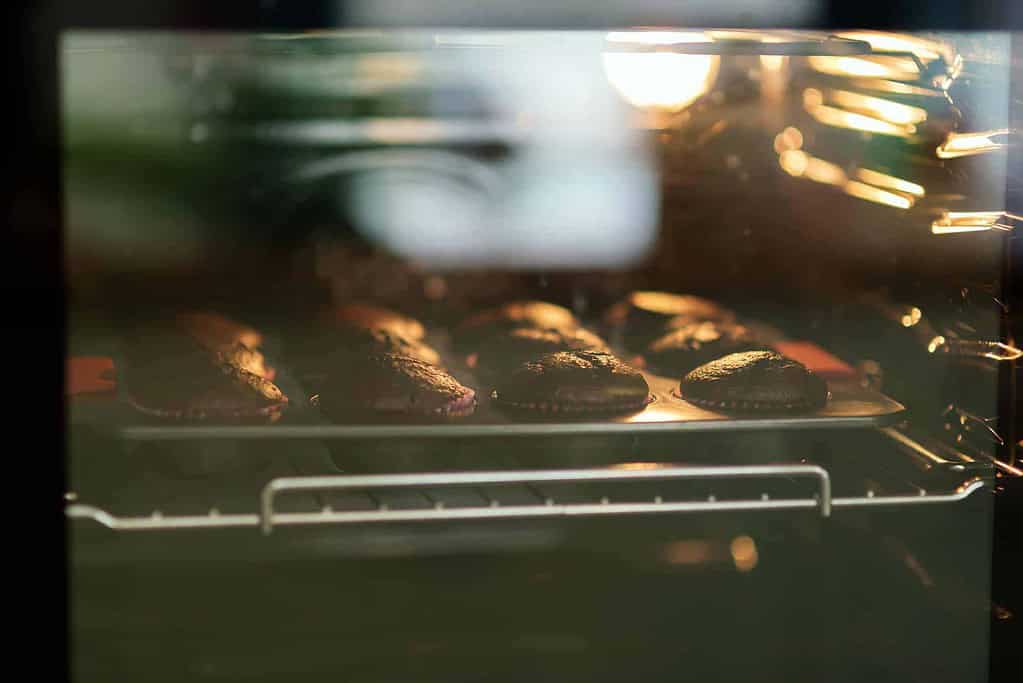Many baking enthusiasts enjoy melting chocolate to make sweet treats, as chocolate is an incredibly versatile medium. However, it takes a bit of work and know-how to ensure melted chocolate hardens properly and quickly.
It takes chocolate 20-30 minutes to harden at room temperature if it’s been tempered. The hardening time halves when tempered chocolate is placed in the refrigerator and cuts down to 5-10 minutes when placed in the freezer.
In this article, I’ll discuss how long it takes for different types of chocolate to harden at room temperature. I’ll also explain what can happen when you harden chocolate in the freezer or refrigerator and provide some helpful tips on speeding up chocolate hardening.

How Long Will It Take for Chocolate To Harden at Room Temperature?
If you want your chocolate to harden quickly and thoroughly, and develop a glossy finish, you need to temper it (source: King Arthur Baking Company). Moreover, untempered chocolate won’t harden completely (source: Cake Decorist).
It will take milk, dark, or white chocolate 20-30 minutes to harden at room temperature if it’s been tempered. Chocolate chips take around 10-15 minutes to harden, while ganache can take between 2 and 4 hours to harden.
Dark, white, and milk chocolate contain varying amounts of cocoa butter. However, if you temper the chocolate and stabilize the cocoa butter crystals, they’ll harden at the same rate (source: Hotel Chocolat).
Below is a helpful table explaining the hardening time at room temperature of various chocolate types:
| Chocolate Type | Hardening Time at Room Temperature |
| Untempered Chocolate | Will not harden completely |
| Tempered Chocolate (Milk, White, or Dark) | 20 to 30 minutes |
| Chocolate Chips | 10 to 15 minutes |
| Ganache | 2 to 4 hours |
Bear in mind that this is a rough guide only, and the hardening process will depend on your kitchen’s ambient temperature.
The average room temperature is 68°F (20°C), but this can be higher if it’s summer and you’ve recently used your oven or stove. Your chocolate will take longer to harden when the temperature is higher than room temperature (source: Julie’s Cafe Bakery).
How Long Before Melted Chocolate Hardens in a Freezer?
You’ve probably heard that placing melted chocolate in a freezer can speed up hardening. This is true, however, the chocolate can bloom in the freezer or refrigerator as it doesn’t like extreme temperature fluctuations (source: Hotel Chocolat).
You’ll need to monitor the chocolate closely by regularly checking how hard it is every few minutes.
Sugar bloom is similar to fat bloom, but instead of the cocoa butter crystals forming irregularly-shaped crystal formation, the sugar particles become separated when they interact with the condensation. This can make your chocolate appear grainy and streaky (source: Chocolate Tempering Machines).
If you don’t have space in your freezer to harden your freshly-prepared chocolate, you can harden it in the refrigerator. Tempered chocolate takes 15 to 20 minutes to harden when refrigerated.
Melted chocolate hardens in a freezer in around 10 – 15 minutes if it was tempered. Chocolate chips only take about 5 minutes, yet ganache can take an hour to harden. Keep in mind that if hot, melted chocolate is placed in an extremely cold place, condensation occurs, resulting in a sugar bloom.
To help reduce and potentially prevent sugar blooming, wrap the chocolate tray with plastic film to protect it from condensation. Alternatively, allow your melted chocolate to cool down at room temperature for a few minutes before placing it in the freezer or refrigerator.
Still, the best way to prevent sugar blooming is to allow your chocolate to harden at room temperature.

How Long Do Chocolate-Covered Strawberries Take To Harden?
Using tempered chocolate to coat strawberries gives them a luscious shine, helping to make chocolate-covered strawberries such a special, decadent treat and an ideal way to spoil someone for Valentine’s Day and other holidays.
Yet, if you’re making them the same day, you must allow enough time for the chocolate to harden before trying to gift wrap or serve, or else you risk a very messy presentation.
Chocolate-covered strawberries take about 30 minutes to harden in the refrigerator if you have used tempered chocolate. It will take half this time if you place them in the freezer. Be sure to add any finely chopped nuts or sprinkles to the layer of chocolate before it hardens, if desired.
Tips on Speeding Up Chocolate Hardening
Here are some tips for speeding up chocolate hardening:
Temper the Chocolate First
High-quality chocolate contains cocoa butter, the substance giving chocolate its creamy, melt-in-the-mouth texture, and smooth taste. Cocoa butter has various fatty acids, which solidify and crystallize at different temperatures.
Tempering chocolate encourages the fatty acid crystals to solidify uniformly, which results in a smooth finish and uniform texture with a shiny appearance. This is done by slowly heating and agitating the chocolate and then allowing it to cool.
When tempered chocolate hardens, it becomes hard and will make a snapping sound if you break it. In contrast, untempered chocolate will have a softer texture and crumble if you try and break it (source: Crafty Baking).
Conversely, untempered, melted chocolate is unstable. After melting and cooling untempered chocolate, the unstable cocoa butter crystals will prevent it from hardening completely, even if you place it in the freezer or refrigerator.
Furthermore, when it starts to solidify, the cocoa butter particles separate from the rest of the chocolate, causing white streaks or dust on the chocolate’s surface. This is called chocolate bloom, and although it makes chocolate look dull and unappetizing, it’s safe to eat.

Here’s how to temper chocolate:
- Melt two-thirds of your chocolate in a double boiler, stirring constantly until the temperature reaches 110°F (43°C). If you’re tempering dark chocolate, heat it to 115°F (46°C). Check the temperature by using a candy thermometer (source: Ghirardelli).
- Remove the container with the chocolate and gradually add the remaining third of the chocolate, stirring continuously. Continue agitating the chocolate until your candy thermometer shows a reading of 84°F (28.9°C).
If you’re in a hurry, you can place the bowl into an ice bath but make sure that you don’t get any water into the chocolate as it will ruin the tempering process. - Once the chocolate reaches 84°F (28.9°C), place it back into the double boiler. Stir the chocolate continuously until it heats up to 89°F (31.6°C).
- Remove the chocolate and test it by dipping a tiny piece of parchment paper. After a few minutes, the chocolate on the parchment paper should look smooth, shiny, and firm. If it seems dull or cloudy, you’ll need to reheat the chocolate and stir in some more chocolate (source: Lindt).
Temper the Chocolate in the Microwave
Tempering your chocolate is the most important way to speed up your chocolate hardening. Many opt to skip this part because it’s time-consuming and labor-intensive, but it pays off in the long run since the chocolate will harden much faster than untempered chocolate.
If you don’t have a double boiler, or you’re in a hurry, you can temper your chocolate in the microwave. This is a more tedious and risky method involving stopping and opening your microwave every few minutes to stir the chocolate and check the temperature.
Avoid remelting your chocolate more than three times because this can dampen the rich flavor notes and make it taste bland.
Cool Down Your Kitchen
If you’re making a large batch of chocolate goodies, it might not be practical to allow it to harden in the refrigerator or freezer. In such cases, cooling down your kitchen can help.
The kitchen is usually the hottest place in the home due to the warmth generated from cooking. Turning down your thermostat as much as possible (or putting the air conditioning on) can help to keep the temperature down in your kitchen and speed up the hardening process.
Opening your kitchen windows and closing the blinds or drapes can help keep the temperature down if you don’t have air conditioning.

Take a Minimalist Approach
Chocolate is delicious and it can be tempting to make your chocolate treats as big as possible and create thick layers over fruit and cakes. Unfortunately, the chocolate hardens faster when there is less of it, and using minimal amounts can save you time.
Use Coconut Oil
Coconut oil can also help to speed up the hardening process because it’s extremely sensitive to temperature fluctuations. When you add it to your cooling chocolate, its temperature will suddenly drop and it will harden (source: Southern Living).
This is emphasized when chocolate is placed in the refrigerator to harden, as the coconut oil helps to quicken this process by a few minutes.
Not to mention, adding a little coconut oil to your melted chocolate is an excellent idea because its nutty flavor notes complement the cocoa in the chocolate.
Conclusion
Chocolate’s hardening time is different under various circumstances, so be sure to keep these tips in mind when you next make chocolatey treats to ensure optimal results!













Comments are closed.